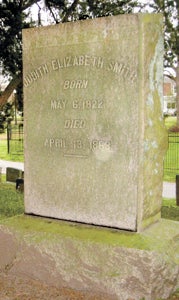An innocent bystander dies
Published 10:59 pm Friday, April 12, 2013
Part 4: A day of tragedy
To mark its 150th anniversary, through May 4, the Suffolk News-Herald will feature a multi-part series by Suffolk historian Kermit Hobbs detailing the 23-day Siege of Suffolk.
By Kermit Hobbs
Special to the News-Herald
Two days into the “siege of Suffolk,” the expected massive attack by the Rebels still had not come. Rather, there had been sporadic rifle and artillery fire on all fronts. Groups of Confederates advanced upon the Union line and were met by equal forces of Yankees sallying forth from their lines.

Judith Kilby Smith was shot and killed during a skirmish between Union and Confederate soldiers near her home on the old Somerton Road on April 13, 1863. Her infant child, whom she had been carrying as she ran for safety, died soon thereafter. Both are buried in Cedar Hill Cemetery. (Kermit Hobbs photo)
When Gen. James Longstreet’s Confederates were advancing upon Suffolk two days earlier, the retreating Federals had burned or destroyed nearly all the trees, houses, and other means of cover that might help an attacking force.
One home that had been spared was the home of Mr. George Robinson Smith, about 3/4 of a mile south of the Union line on Somerton Road (now known as Carolina Road.)
At around 10 a.m., Mr. Robinson looked out of his upstairs window and saw Confederate soldiers around his house, moving toward the enemy. Union soldiers were approaching from Suffolk. Then the shooting started. What happened next was best told in a Petersburg newspaper some time later.
“We think that it may be truly said that one of the most distressing scenes of the whole war occurred near the town of Suffolk, Virginia, in the month of April, 1863, while Gen. Longstreet was investing that town.
“On the memorable day in question heavy skirmishing was going on in the fields surrounding the home of Mr. George Robinson Smith, near Suffolk, and hard fighting continued on either side of the buildings. The family being taken by surprise, all remained in the house — father, mother and seven children. The oldest son, William Robinson Smith, was serving as a gallant soldier in the 16th Virginia elsewhere.
“Let us look upon that family. We first see them seek shelter in the cellar; but, presently, a shell bursts through the house over their heads, scattering splinters in every direction. At length, they seek safety by running toward the woods across the carefully tilled fields amidst the whistling bullets and the terrifying roar of cannon. Alas! When almost at the haven of safety, see the devoted wife with an infant child in her arms (Little Martha, or Mattie, as they called her) tumbling headlong beneath the fatal ball! See her bleeding and dying, struck down in all the vigor and strength of health and beauty, for she was a lovely woman. The fight still rages!! See those seven helpless children scattering like a brood of partridges, each in wild despair flying to the woods, dodging hither and thither, as the poor sparrow would fly from the eagle’s talons. See their home bursting into flames and within a few short hours every vestige of the estate swept from existence!! See those motherless children, one an infant, reduced from plenty and comfort to a most unhappy state but for the timely rescue of kind relatives and friends.
“See the devoted husband, taking the lifeless form of his wife and taking it to Suffolk to the home of her brother for burial. As he passes down the street with his wife’s body, a number of gentlemen are standing in line, preparatory to being marched to Norfolk as prisoners!! Suffolk citizens!! Southerners!! Among them is the Hon. John R. Kilby, brother of this noble dead woman.
“Mrs. Smith was one of the best of women: as a wife, mother, friend, without a fault. All knew her but to love her.”
Many of the existing firsthand accounts of the Siege of Suffolk mention the death of Mrs. Smith. Even in a setting of warfare, where death was common, there was a particular sorrow at the loss of an innocent bystander. The incident was regretted by people on both sides of the conflict.
Judith Kilby Smith was buried alongside her infant daughter Mattie, who followed her in death soon after. Their graves are in Cedar Hill Cemetery near the south gate.
The site of the Smith home is marked by two rows of trees on the west side of Carolina Road at the intersection of Dill Road.
Tomorrow: Part 5: Gunboats on the Nansemond





